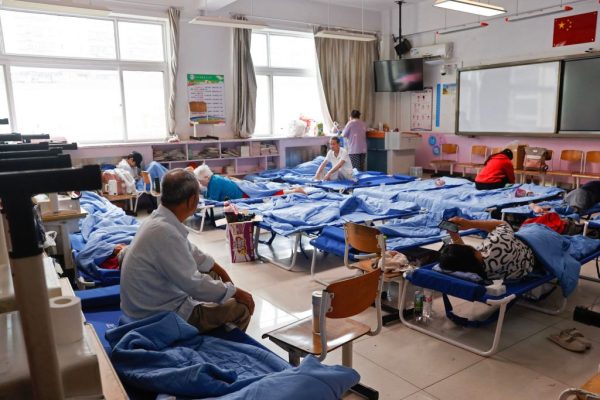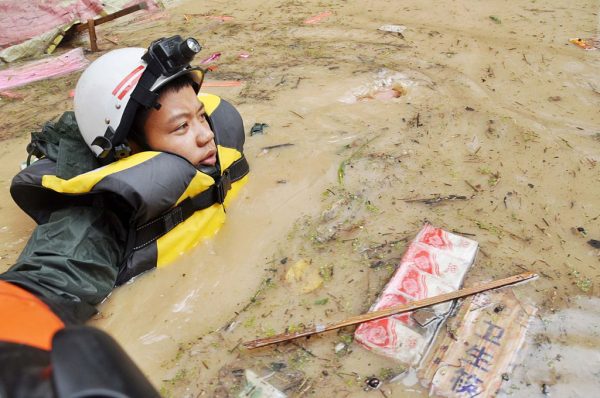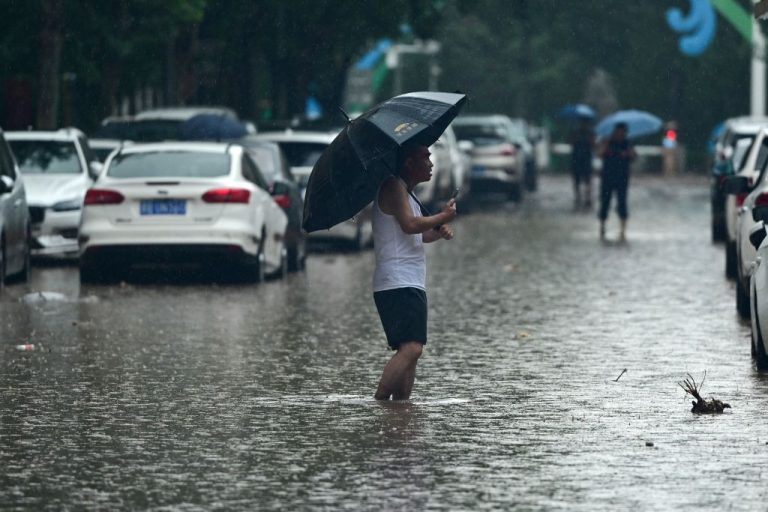Torrential rains bearing down on China’s capital of Beijing and its neighboring cities have resulted in disastrous consequences. The government reported on Aug. 1 that at least 20 people had lost their lives, and 27 are still missing. The heavy downpours have devastated infrastructure — uprooting trees, demolishing roads, sinking homes — and causing widespread power outages.
Thousands evacuated
To ensure their safety, thousands of residents were moved to shelters set up in schools and other public buildings located in suburban Beijing, and in nearby cities of Tianjin and Zhuozhou, local media reported.
State broadcaster CCTV reported that as of July 31, more than 31,000 people were ordered to leave Beijing due to the risk of severe flooding. In addition, state mouthpiece Xinhua News Agency reported that flood and heavy rain conditions had forced another 500,000 people to evacuate from Fujian Province, where tropical storm-turned-typhoon Doksuri made landfall late last week.

MORE ON EXTREME WEATHER IN ASIA:
- Tropical Storm Doksuri to Evolve Into a Super Typhoon, Threatens Taiwan, Hong Kong and the Chinese Mainland
- Typhoon Talim Sideswipes Hong Kong, Slams into Southern China
- Record-Smashing Heatwaves Rip Across China’s Northwest, Projected to Last for Days
- Beijing Records Hottest June Day Since 1961
Casualty toll and response
According to Xinhua, at least 11 of the deaths occurred in Beijing. Another nine fatalities were reported in Hebei Province, the territory of which surrounds the capital. The Fangshan district in Beijing also experienced a blackout, affecting approximately 60,000 homes, Phoenix TV reported.
In Zhuozhou, located southwest of Beijing, some 125,000 people from high-risk areas were relocated to shelters, Xinhua reported. In response to the crisis, China’s President Xi Jinping issued an order for local governments to increase search and rescue operations to “make every effort” to try and rescue those trapped, and limit the loss of life and property damage.
Success
You are now signed up for our newsletter
Success
Check your email to complete sign up
The government of Tianjin, a port city east of Beijing, reported that an additional 35,000 people were evacuated from areas near the overflowing Yongding River.
Unusual weather patterns
Beijing, which typically experiences dry summers, has recently experienced record-breaking heat waves — making the floods all the more unexpected and devastating. While Beijing grapples to minimize damage and ensure the safety of its residents, other parts of the country — particularly in southern regions — have also been experiencing unusually intense summer flooding that has resulted in numerous fatalities.
According to the country’s National Meteorological Center, China’s coast often faces tropical storms surging from the Pacific Ocean. But the amount of rain and flooding brought on by tropical storm Doksuri has not been seen in 70 years, several media outlets reported. The storm, which evolved into a typhoon late last week, also unleashed torrential rains in Hebei Province — where nine people died and six people are still reported as missing.
But what’s unusual is that Doksuri not only affected the nearby city of Tianjin, it also caused heavy rains in regions such as Jilin Province, located about 600 miles to the northeast, as well as in Guangdong Province, which is over a thousand miles to the south.
The scale of the destruction is vast, videos shared on social media show. Streets turned into raging rivers of muddy water in the Mentougou district, on the western edge of Beijing, washing away parked cars. Resident Liu Shuanbao recounted the shock and the speed of the devastation. “The cars parked on the street floated and got washed away,” he said. “A couple of cars parked behind my apartment building disappeared in just one minute.”
Destructive forces unleashed
On Aug. 1, emergency workers were seen deploying bulldozers to clear streets while residents waded through mud and debris.
Wu Changpo, a resident from Beijing’s Mentougou district, said the floods had taken an emotional toll on those who live nearby. “Neither officials nor ordinary people expected the rain to be so heavy,” said Wu. “There were a lot of landslides and flooded villages. I cried repeatedly seeing these reports.”
Since July 29, some areas have received almost 20 inches of rainfall, according to Hebei Province’s weather agency. Other regions reported as much as 3 1/2 inches of rainfall per hour.
The Ministry of Water Resources has warned that 13 rivers in the Haihe Basin, which includes Beijing, Tianjin, and Shijiazhuang, have exceeded safe levels, and issued stay-at-home orders for residents affected by these conditions.
In Shanxi province, west of Hebei, about 42,000 people were evacuated due to the threat of flooding resulting from torrential rains.
Prior incidents
In early July, at least 15 people were killed by floods in the southwestern region of Chongqing. Nearly 5,590 people had to be evacuated in the far northwestern province of Liaoning. In Hubei, a central province, rainstorms trapped residents in their vehicles and homes.

China’s deadliest and most destructive floods in recent history occurred in 1998, claiming the lives of 4,150 people — most of whom resided along the Yangtze River.
In 2021, more than 300 people perished in the flooding in the central province of Henan. Record rainfall also swamped the provincial capital of Zhengzhou on July 20 — transforming streets into rushing rivers and flooding parts of a subway line.
In neighboring South Korea, severe rainfall led to landslides and flash floods, claiming at least 41 lives. Among the fatalities, at least 13 people lost their lives when an underpass flooded, trapping vehicles and debris in surging floodwaters.














